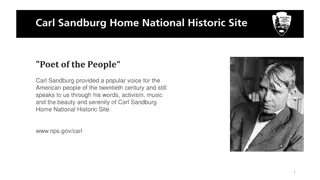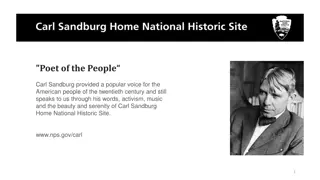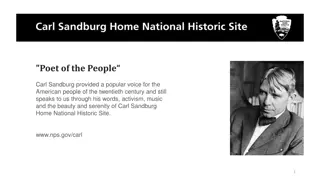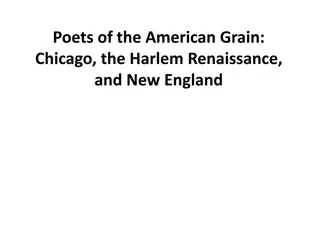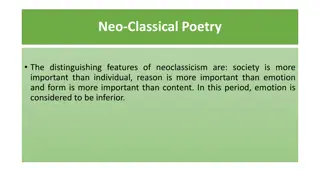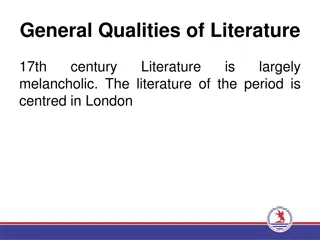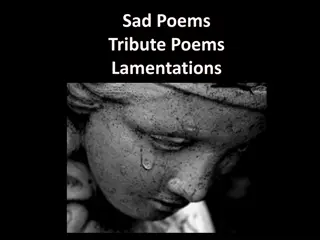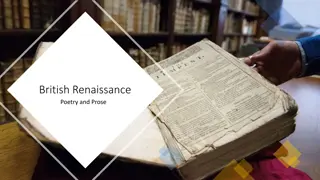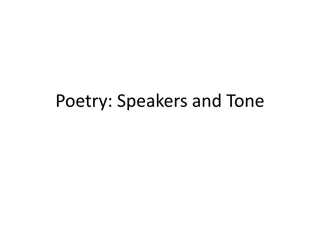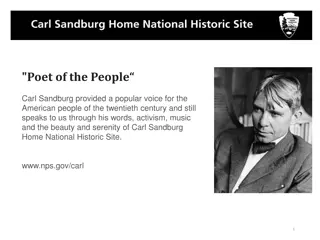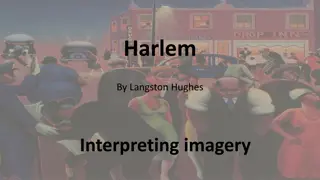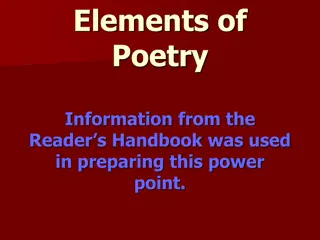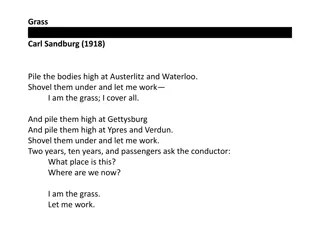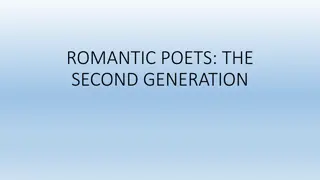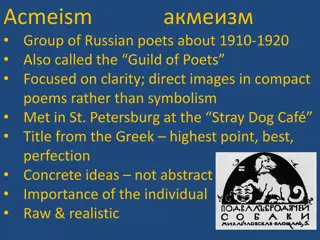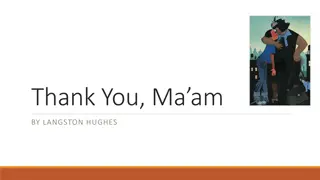Explore Poetry with Poets Langston Hughes, Edna St. Vincent Millay, Naomi Madgett, and Carl Sandburg
Delve into the world of poetry with renowned poets Langston Hughes, Edna St. Vincent Millay, Naomi Madgett, and Carl Sandburg. Discover the themes, structures, and figurative language in their works to enhance your appreciation for poetry.
Download Presentation

Please find below an Image/Link to download the presentation.
The content on the website is provided AS IS for your information and personal use only. It may not be sold, licensed, or shared on other websites without obtaining consent from the author. Download presentation by click this link. If you encounter any issues during the download, it is possible that the publisher has removed the file from their server.
E N D
Presentation Transcript
Life Mother to Son Carl Langston Hughes Sandburg Fog The Courage That My Mother Had Edna St. Vincent Millay Naomi Madgett
Objectives CCSS.ELA-LITERACY.RL.8.1 Cite several pieces of textual evidence to support analysis of what the text says explicitly as well as inferences drawn from the text. CCSS.ELA-LITERACY.RL.8.2 Determine a theme or central idea of a text and analyze its development over the course of the text; provide an objective summary of the text. CCSS.ELA-LITERACY.RL.8.4 Determine the meaning of words and phrases as they are used in a text, including figurative and connotative meanings; analyze the impact of rhymes and other repetitions of sounds (e.g., alliteration) on a specific verse or stanza of a poem or section of a story or drama. CCSS.ELA-LITERACY.RL.8.5 Analyze how a drama's or poem's form or structure (e.g., soliloquy, sonnet) contributes to its meaning CCSS.ELA-LITERACY.RL.8.10 By the end of the year, read and comprehend literature, including stories, dramas, and poems, in the grades 6-8 text complexity band proficiently, with scaffolding as needed at the high end of the range.
Naomi Madgett Carl Sandburg Read more about the poets on the slides in front of their poems. Or, click on the links below. http://www.naomilongmadgett.com/ http://www.poetryfoundation.org/bio/carl- sandburg
Langston Hughes Edna St. Vincent Millay Read more about the poets on the slides in front of their poems. Or, click on the links below. http://www.americanwriters.org/writers/hughes_hurston.asp http://www.poetryfoundation.org/bio/langston-hughes http://www.poetryfoundation.org/bio/edna-st-vincent-millay
Analyze a Poem: 5 Easy Steps STEP 1: Read the poem. Look up any words that you do not understand in the dictionary. STEP 2: Read the poem out loud. Look at the structure of the poem. How many stanzas are there? Is there a rhyme or rhythm that gives it a particular feeling? STEP 3: Look through the poem slowly and try to find examples of figurative language (metaphor, simile and personification). Look for examples of imagery and sensory language. How do these things affect you? What do they express? STEP 4: Read the poem again thinking about the speaker. What kind of person are they? What is their situation? How do they think and feel and what are they trying to express? STEP 5: Reread the title of the poem and see if it gives you a clue about what the poem is about. Reread the poem one last time and think about the theme. Write down what you think the poem is about.
Figurative Language Before we read the poems, let s refresh our memories about: Similes Metaphors Symbolism
Similes A comparison that uses like or as Example: My dog is like a clown; he is so silly!
Metaphors A comparison that does NOT use like or as Example: My bird is an alarm clock. He wakes me up at 5 every morning! An extended metaphor is one that extends-or lasts-through several sentences or paragraphs.
Symbol An item that represents or stands for something else. A material object representing something immaterial. Example: People often use doves as a symbol of peace.
Examples of Symbols A dove is often used as a symbol of peace. http://ts2.mm.bing.net/images/thumbnail.aspx?q=1293396347125id=0615681136373761d1cc7836820a796a A heart symbolizes love. This sign symbolizes poison.
The peace symbol represents peace. All around the world, the Statue of Liberty is a symbol of freedom.
Naomi Madgett July 5th, 1923- Published her first book of poetry at 17 "I do not recall any time in my life when I was not involved with poetry," Teacher-high school and college Poet and publisher
Life by Naomi Madgett Life is but a toy that swings on a bright gold chain Ticking for a little while To amuse a fascinated infant, Until the keeper, a very old man, Becomes tired of the game And lets the watch run down. What image does Madgett use to describe life? Is this an effective image to use? Why or why not? What do we call this type of comparison? Key Ideas and Details
Use the graphic organizer to connect details from the poem to reach the conclusion given. Detail: Detail: Detail: The speaker believes that people lose interest in life as they grow older. Drawing Conclusions
Carl Sandburg 1878-1967 , Galesburg , IL
Fog by Sandburg Figurative Language: What is the metaphor that Sandburg uses to describe the fog? The fog comes on little cat feet. It sits looking over harbor and city on silent haunches and then moves on. Why is this an appropriate metaphor for fog? (Think-how are these two things alike?)
Langston Hughes Langston Hughes was one of the foremost poets of the Harlem Renaissance. The Harlem Renaissance was a period of immense growth in the area of arts by African Americans. Langston Hughes became the voice of many speaking about daily life and struggles of African Americans, as well as the beauty and strength of them. He wrote many poems about the joy of living as well as the hardships.
Mother to Son by Langston Hughes
Well, son, I'll tell you: Life for me ain't been no crystal stair. It's had tacks in it, And splinters, And boards torn up, And places with no carpet on the floor -- Bare. But all the time I'se been a-climbin' on, And reachin' landin's, And turnin' corners, And sometimes goin' in the dark Where there ain't been no light. So boy, don't you turn back. Don't you set down on the steps 'Cause you finds it's kinder hard. Don't you fall now -- For I'se still goin', honey, I'se still climbin', And life for me ain't been no crystal stair.
Well, son, I'll tell you: Life for me ain't been no crystal stair. It's had tacks in it, And splinters, And boards torn up, And places with no carpet on the floor -- Bare. What does the staircase symbolize? When the staircase is compared to life, this makes it a metaphor. The tacks, splinter and torn-up boards symbolize what part of life? The bare floors symbolize a time in life when the family is_______________
But all the time I'se been a-climbin' on, And reachin' landin's, And turnin' corners, And sometimes goin' in the dark Where there ain't been no light. What do you think the landings and corners symbolize? How do you feel after climbing twenty stairs and reaching a landing? What is it like when you walk through the dark? How does it make you feel?
So boy, don't you turn back. Don't you set down on the steps 'Cause you finds it's kinder hard. Don't you fall now -- For I'se still goin', honey, I'se still climbin', And life for me ain't been no crystal stair. Because this metaphor lasted the entire poem, we will call it an extended metaphor. What advice is the mother giving her son? Is this advice that others should follow also?
Mother speaking to her son She hasn t had a smooth, easy life Well, son, I'll tell you: Life for me ain't been no crystal stair. It's had tacks in it, And splinters, And boards torn up, And places with no carpet on the floor -- Bare. But all the time I'se been a-climbin' on, And reachin' landin's, And turnin' corners, And sometimes goin' in the dark Where there ain't been no light. So boy, don't you turn back. Don't you set down on the steps 'Cause you finds it's kinder hard. Don't you fall now -- For I'se still goin', honey, I'se still climbin', And life for me ain't been no crystal stair. Obstacles Times of poverty Continuing Perseverance Making progress Continuing even in the darkest of times, when it seemed there was no hope Don t give up when life is hard and difficult. Don t give up or expect life to be easy. If I can keep going-so can you!
Well, son, I'll tell you: Life for me ain't been no crystal stair. It's had tacks in it, And splinters, And boards torn up, And places with no carpet on the floor -- Bare. But all the time I'se been a-climbin' on, And reachin' landin's, And turnin' corners, And sometimes goin' in the dark Where there ain't been no light. So boy, don't you turn back. Don't you set down on the steps 'Cause you finds it's kinder hard. Don't you fall now -- For I'se still goin', honey, I'se still climbin', And life for me ain't been no crystal stair. What is the overall THEME of this poem? How do we know? What would a summary be for this poem? What emotions/feelings are expressed in this poem?
Edna St. Vincent Millay Poet Playwright Millay was an accomplished writer at an early age. When Millay was fifteen, she had her first poem published!
The Courage That My Mother Had by Edna St. Vincent Millay
The courage that my mother had Went with her, and is with her still: Rock from New England quarried; Now granite in a granite hill. The golden brooch my mother wore She left behind for me to wear; I have no thing I treasure more: Yet, it is something I could spare. Oh, if instead she d left to me The thing she took into the grave! That courage like a rock, which she Has no more need of, and I have.
The courage that my mother had Went with her, and is with her still: Rock from New England quarried; Now granite in a granite hill. Three quatrains make up this poem. Think of the word QUAtrain. What other words have a similar letter pattern? Stanza One The golden brooch my mother wore She left behind for me to wear; I have no thing I treasure more: Yet, it is something I could spare. Oh, if instead she d left to me The thing she took into the grave! That courage like a rock, which she Has no more need of, and I have. Stanza Two Quarter Quart Quad Quadrangle What pattern do you see? Stanza Three
Rhyme Pattern When a poem has a pattern of end line rhymes, we show the pattern by using letters. Each end sound is marked with a letter, starting with A. New sounds receive the next letter of the alphabet, and repeating rhyme sounds have the same letter as each other. Roses are red, Violets are blue, I love books, And so do you! A B C B
The courage that my mother had Went with her, and is with her still: Rock from New England quarried; Now granite in a granite hill. A B A B The golden brooch my mother wore She left behind for me to wear; I have no thing I treasure more: Yet, it is something I could spare. Oh, if instead she d left to me The thing she took into the grave! That courage like a rock, which she Has no more need of, and I have. C D C D E F E F
Based on what the speaker says, what can we assume happened to the mother? The courage that my mother had Went with her, and is with her still: Rock from New England quarried; Now granite in a granite hill. What is granite used for? What does a granite hill symbolize?
The golden brooch my mother wore She left behind for me to wear; I have no thing I treasure more: Yet, it is something I could spare. The brooch may symbolize the mother, but it is a material item. Even though the speaker treasures it, she wishes for something else instead.
Oh, if instead shed left to me The thing she took into the grave! That courage like a rock, which she Has no more need of, and I have. When a comparison is made using the word like we call this a simile. courage like a rock
The courage that my mother had Went with her, and is with her still: Rock from New England quarried; Now granite (in a granite hill). The courage is compared to a rock - rocks are hard, strong, and stay still- never wavering. Her mother s courage was the same-strong and steady. The rock is now granite in a granite hill. Granite is used for tombstones; a granite hill would be a cemetery. Millay implies that the courage is now buried with her mother. The golden brooch my mother wore She left behind for me to wear; I have no thing I treasure more: Yet, it is something I could spare. Oh, if instead she d left to me The thing she took into the grave! That courage like a rock, which she Has no more need of, and I have.
The courage that my mother had Went with her, and is with her still: Rock from New England quarried; Now granite in a granite hill. Millay treasures /cares for the golden brooch as a symbol of her mother-but she is aware that the gold, while treasure of value is only a material good. The golden brooch my mother wore She left behind for me to wear; I have no thing I treasure more: Yet, it is something I could spare. Oh, if instead she d left to me The thing she took into the grave! That courage like a rock, which she Has no more need of, and I have. Millay uses the word treasure to show the contrast between treasure of material value and treasure as a verb to mean that she cherishes the item.
The courage that my mother had Went with her, and is with her still: Rock from New England quarried; Now granite in a granite hill. The golden brooch my mother wore She left behind for me to wear; I have no thing I treasure more: Yet, it is something I could spare. Oh, if instead she d left to me The thing she took into the grave! That courage like a rock, which she Has no more need of, and I have. She wishes that she had the same strength her mother had. The speaker in the poem is quite aware that the value of the brooch is nothing compared to the value of courage. She shows that material goods/possessions have no value when compared to the things that truly matter in life.
The courage that my mother had Went with her, and is with her still: Rock from New England quarried; Now granite in a granite hill. What is the overall theme for this poem? How do we know? What is a summary for this poem? The golden brooch my mother wore She left behind for me to wear; I have no thing I treasure more: Yet, it is something I could spare. Oh, if instead she d left to me The thing she took into the grave! That courage like a rock, which she Has no more need of, and I have. What feelings/emotions are expressed in this poem?
Use the graphic organizer to connect details from the poem to reach the conclusion given. Detail: Detail: Detail: The speaker admires her mother. Drawing Conclusions
Check Your Comprehension 1. In Mother to Son what advice does the mother give to her son? 2. Where is the speaker in The Courage That My Mother Had ? 3. For what quality does the speaker of The Courage That My Mother Had wish?
Critical Thinking 1.(a) In Mother to Son, what does the mother say about her life? (b) What comparison does she make to develop this point? 2.In Lines 14-17 of Mother to Son, what does the mother say about how to live? 3.Explain lines 3-4 in The Courage That My Mother Had.
Critical Thinking 4.Why does Millay compare her mother to New England granite? 5.Why would Millay rather have her mother s character than a brooch made of gold? 6.Describe the feeling that the speaker expresses in The Courage That My Mother Had.
Evaluate What qualities do you think the women in Mother to Son and The Courage That My Mother Had share?
Evaluate How do the poets feel about the mothers in the poems? How do we, as readers, know this?
The Courage That My Mother Had What two symbols does the speaker use to represent her mother?
Mother to Son In this poem, who is the speaker? To whom is she speaking?
Extend-Word Connections Word Symbolizes Brooch Mother Granite Treasure Poverty Tacks Staircase Progress



